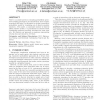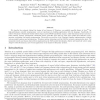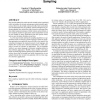3185 search results - page 199 / 637 » Principles for modeling language design |
KDD
2004
ACM
14 years 8 months ago
2004
ACM
There is a notable interest in extending probabilistic generative modeling principles to accommodate for more complex structured data types. In this paper we develop a generative ...
GECCO
2003
Springer
14 years 1 months ago
2003
Springer
The process of labeling each word in a sentence with one of its lexical categories (noun, verb, etc) is called tagging and is a key step in parsing and many other language processi...
LREC
2008
13 years 9 months ago
2008
We introduce the corpus of United States Congressional bills from 1947 to 1998 for use by language research communities. The U.S. Policy Agenda Legislation Corpus Volume 1 (USPALC...
IJHPCA
2007
13 years 8 months ago
2007
We describe the rationale behind the design of key features of Titanium—an explicitly parallel dialect of JavaTM for high-performance scientific programming—and our experienc...
CCR
2008
13 years 8 months ago
2008
Flow records gathered by routers provide valuable coarse-granularity traffic information for several measurement-related network applications. However, due to high volumes of traf...



